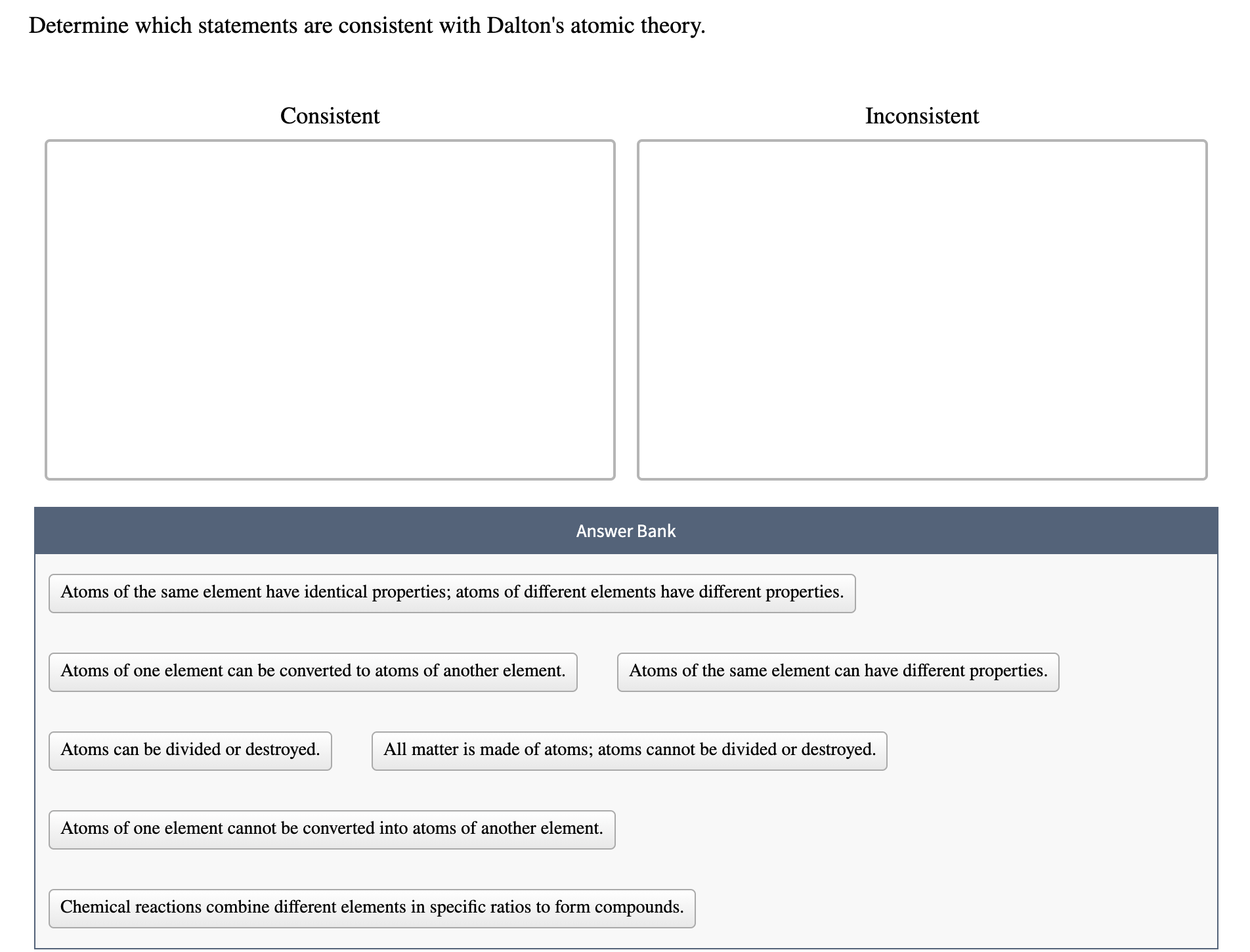Determine which statements are consistent with Dalton's atomic theory. Consistent Inconsistent Answer Bank Atoms of the same element have identical properties; atoms of different elements have different properties. Atoms of one element can be converted to atoms of another element. Atoms of the same element can have different properties. Atoms can be divided or destroyed. All matter is made of atoms; atoms cannot be divided or destroyed. Atoms of one element cannot be converted into atoms of another element. Chemical reactions combine different elements in specific ratios to form compounds.
Determine which statements are consistent with Dalton's atomic theory. Consistent Inconsistent Answer Bank Atoms of the same element have identical properties; atoms of different elements have different properties. Atoms of one element can be converted to atoms of another element. Atoms of the same element can have different properties. Atoms can be divided or destroyed. All matter is made of atoms; atoms cannot be divided or destroyed. Atoms of one element cannot be converted into atoms of another element. Chemical reactions combine different elements in specific ratios to form compounds.
Introductory Chemistry: A Foundation
9th Edition
ISBN:9781337399425
Author:Steven S. Zumdahl, Donald J. DeCoste
Publisher:Steven S. Zumdahl, Donald J. DeCoste
Chapter4: Chemical Foundations: Elements, Atoms, And Ions
Section: Chapter Questions
Problem 88AP
Related questions
Concept explainers
Atomic Structure
The basic structure of an atom is defined as the component-level of atomic structure of an atom. Precisely speaking an atom consists of three major subatomic particles which are protons, neutrons, and electrons. Many theories have been stated for explaining the structure of an atom.
Shape of the D Orbital
Shapes of orbitals are an approximate representation of boundaries in space for finding electrons occupied in that respective orbital. D orbitals are known to have a clover leaf shape or dumbbell inside where electrons can be found.
Question

Transcribed Image Text:Determine which statements are consistent with Dalton's atomic theory.
Consistent
Inconsistent
Answer Bank
Atoms of the same element have identical properties; atoms of different elements have different properties.
Atoms of one element can be converted to atoms of another element.
Atoms of the same element can have different properties.
Atoms can be divided or destroyed.
All matter is made of atoms; atoms cannot be divided or destroyed.
Atoms of one element cannot be converted into atoms of another element.
Chemical reactions combine different elements in specific ratios to form compounds.
Expert Solution
This question has been solved!
Explore an expertly crafted, step-by-step solution for a thorough understanding of key concepts.
This is a popular solution!
Trending now
This is a popular solution!
Step by step
Solved in 3 steps

Knowledge Booster
Learn more about
Need a deep-dive on the concept behind this application? Look no further. Learn more about this topic, chemistry and related others by exploring similar questions and additional content below.Recommended textbooks for you

Introductory Chemistry: A Foundation
Chemistry
ISBN:
9781337399425
Author:
Steven S. Zumdahl, Donald J. DeCoste
Publisher:
Cengage Learning

Introductory Chemistry: An Active Learning Approa…
Chemistry
ISBN:
9781305079250
Author:
Mark S. Cracolice, Ed Peters
Publisher:
Cengage Learning


Introductory Chemistry: A Foundation
Chemistry
ISBN:
9781337399425
Author:
Steven S. Zumdahl, Donald J. DeCoste
Publisher:
Cengage Learning

Introductory Chemistry: An Active Learning Approa…
Chemistry
ISBN:
9781305079250
Author:
Mark S. Cracolice, Ed Peters
Publisher:
Cengage Learning


Chemistry
Chemistry
ISBN:
9781305957404
Author:
Steven S. Zumdahl, Susan A. Zumdahl, Donald J. DeCoste
Publisher:
Cengage Learning


Chemistry: Principles and Practice
Chemistry
ISBN:
9780534420123
Author:
Daniel L. Reger, Scott R. Goode, David W. Ball, Edward Mercer
Publisher:
Cengage Learning